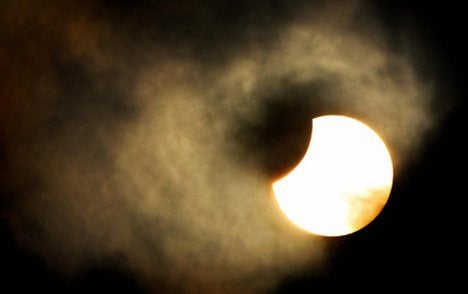
So it will appear relatively small in the night sky, something that explains why it goes so deeply into-and spends so long inside-Earth’s shadow.

Well, shortly after this eclipse-just under 2 days later-the Moon reaches the apogee of its slightly elliptical orbital path around the Earth. An almost total lunar eclipse will be visible for all of North America, including Hawaii.
LUNAR ECLIPSE TIME IN HAWAII FULL
However, that’s not a hugely useful definition because at a total lunar eclipse-which this is not-you get an additional period of up to a few hours when the full Moon can reside within the Earth’s shadow, 100% eclipsed and reddish.īut why is this such a long partial eclipse? That’s because it’s a very deep eclipse. The true maximum point of this eclipse cannot be seen in Hawaiian Homes because the Moon is below the horizon at that time. It’s also the longest partial lunar eclipse since 1440 and until the year 2669. Maximum in Hawaiian Homes This is the moment when the eclipse reaches its greatest magnitude while the entire Moon is above the horizon in Hawaiian Homes. All times are local time ( HST) for Hawaiian Islands. That’s when the penumbra, or peripheral darkening associated with the Earth’s shadow. Stages and times of the eclipse are outlined below. The lunar eclipse will begin at 1:02 a.m. The partial lunar eclipse will last three hours 28 minutes and 23 seconds making it the longest partial lunar eclipse between 20 according to NASA. at 6:25 am Max at Sunrise in Hawaiian Islands OctoAnnular Solar Eclipse Hawaiian Islands The animation shows what the eclipse approximately looks like in Hawaiian Islands. A lunar eclipse occurs when the Sun, Earth, and Moon align so that the Moon. It’s the longest partial lunar eclipse this century In Honolulu, the total eclipse begins at 2:51 am local time in Anchorage. NASA's Scientific Visualization Studio 5. Part of it will remain in the umbra until 2:53 a.m. HST, with the Moon entering the darkest part of the Earth’s shadow at 11:45 p.m. diagram with the times at various stages of the eclipse. The eclipse is set to begin May 25 at 10:46 p.m. The Moon moves right to left, passing through the penumbra and umbra, leaving in its wake an eclipse. To see Earth’s shadow recede across the Moon and drain it of color, simply keep on watching past the point of near-totality. HST (Hawaii) on Thursday, November 18, 2021 AKST (Alaska) on Thursday, November 18, 2021 That’s the edge of Earth’s massive shadow! You’ll only see that if you watch the waxing partial eclipse phase before the “near-totality.” Here’s when to see our planet’s mighty shadow move across the Moon: An almost total lunar eclipse will be visible for all of North America, including Hawaii. For best viewing, be sure to look toward the south east direction. red” is one option, for me at least as interesting a sight is the almost straight, but slightly curved line moving across the Moon to envelope it in color. The climax of the eclipse, when the moon will be glowing most red, will happen at 1:18 a.m. Get up earlier to se a ‘Half Blood Moon’Īlthough seeing the Moon at “max. "It's as if all the world's sunrises and sunsets are projected onto the Moon," NASA said.The sight of Earth's shadow moving across the lunar surface is strange to behold. The more cloudy or dusty the atmosphere is, the redder the moon looks.

The phenomenon causes the moon to appear red, often nicknamed a "blood moon." During a lunar eclipse, what little sunlight that's left passes through Earth's atmosphere to get to the moon. The eclipse will begin before the moon rises over the West. During a full lunar eclipse, the moon falls completely in the Earth's shadow. The middle of the eclipse will be the best time to look at the moon and will occur at 12:11 a.m. The eclipse could be viewed across much of North America, South America, Asia and Australia.Ī lunar eclipse happens when the sun, Earth and moon align. The lunar disk entered totality at 5:17 a.m. Just over an hour later, the partial eclipse began - when, to the naked eye, it looks like a bite was being taken out of the moon. The initial phase of the eclipse began at 3:02 a.m. The total lunar eclipse will be visible everywhere in the Pacific and. For about an hour and a half on Tuesday morning, the moon appeared a deep shade of red - an astronomical delight for many, or perhaps an Election Day omen, depending on who you ask.Īcross Asia, Australia and the Americas, people woke up early and stayed up late to take in the planet's last full lunar eclipse until 2025. This map shows the visibility of the total lunar eclipse in the contiguous U.S.


 0 kommentar(er)
0 kommentar(er)
